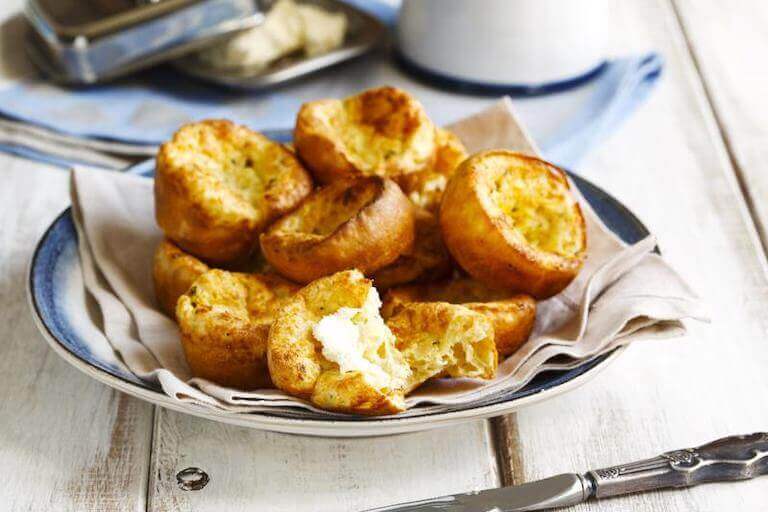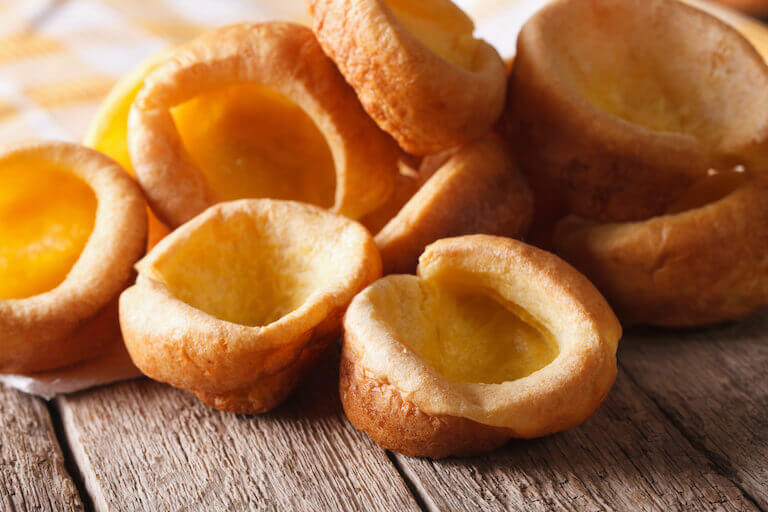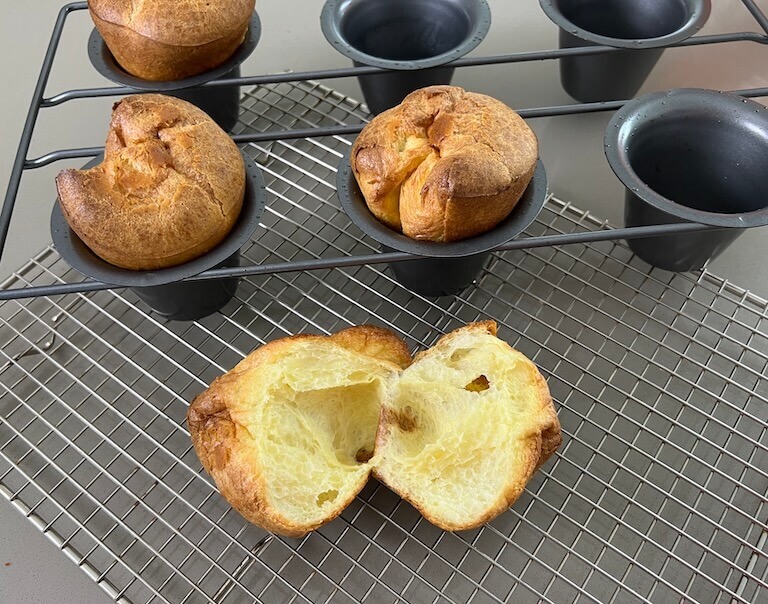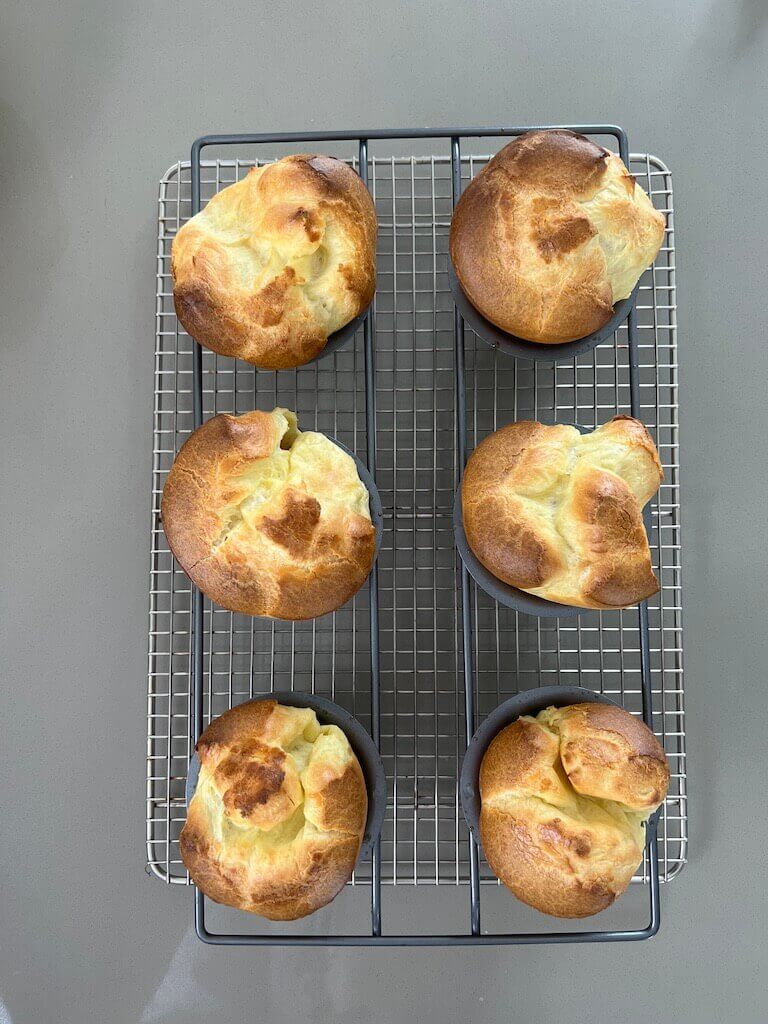It isn’t a muffin. It isn’t a cupcake. It isn’t a frittata. It’s a popover. When it comes to simple baked goods with the potential for complex flavor combinations, the popover is perhaps king.
The beauty of the popover is that, like a croissant, it’s delicious enough to be eaten by itself or with just a light spread of butter, but it can also be filled with just about anything under the sun! If you’re new to the world of popovers, here’s what you need to know about this buttery treat, including a recipe you can whip up at home.
What Is a Popover?
The popover, considered the “American twist” on the classic Yorkshire pudding, is particularly popular in New England cities like Boston. According to The Kitchn, popovers are airy and fluffy in nature—boasting a golden brown exterior like Yorkshire pudding. In fact, this pastry is made with a similar batter of flour, salt, eggs, milk, and butter.
Another fun fact—a popover gets its name from the “dramatic rise” caused by the steam. According to Escoffier Chef Instructor Colette Christian, the batter has a high proportion of liquid to flour, so steam is created as the excess moisture heats up. The protein in the eggs and flour form a matrix that’s soft enough to expand with the steam and durable enough to hold it.

A slew of freshly baked, savory popovers.
Main Differences Between Popovers and Yorkshire Pudding
So you might be wondering—what are the main differences between popovers and Yorkshire pudding that look almost identical? Let’s examine a few side-by-side differences.
Origin Country
As we alluded to earlier, popovers were invented in America, while Yorkshire pudding was first conceptualized in England. Also, in the United Kingdom, “pudding” is referenced as a steamed, baked, fried, or boiled cake, but in the U.S., pudding is considered to be a velvety-smooth custard. However, both popovers and Yorkshire pudding exhibit the same sort of texture and consistency!
Cooking Fat
Traditionally, in England, Yorkshire pudding is assembled with leftover meat drippings from Sunday roast, which typically adds a more savory flair to the final result. But when it comes to baking popovers, Americans default to old-fashioned butter—amplifying its overall flakiness.

Yorkshire pudding, not to be confused with popovers.
Baking Method
When it comes to baking popovers, professional bakers will opt for a special popover pan—essentially, a slightly deeper, more cylindrical muffin pan.
A Yorkshire pudding is usually made with a typical, angled pan, that’s much more shallow than a conventional muffin pan. This type of pan typically garners more leveled pastries that don’t “tower” like popovers.
A Popover Recipe
As we mentioned towards the beginning, you only need a few simple ingredients to bake a warm, delectable popover. Here’s a tried a true recipe by Escoffier Chef Instructor, Colette Christian that will yield six popovers, but can easily be doubled to make 12.

Ingredients:
- 221g all-purpose flour, unbleached
- 425g milk
- 225g eggs
- 85g butter
- 4g salt (½ teaspoon)

Instructions:
- Preheat the oven to 450 degrees Fahrenheit.
- In a blender or food processor fitted with a metal blade, combine all ingredients.
- Blend for 30 seconds, stop the machine and scrape down.
- Blend for an additional 15 seconds.
- Chill the batter for a minimum of 15 minutes or up to 24 hours before baking.
- Fill popover cups two-thirds full.
- Bake at 450 degrees Fahrenheit for 20 minutes.
- Reduce the temperature to 350 degrees Fahrenheit and bake for an additional 10 minutes.
- When the popovers come out of the oven – piece the tops with the tip of a paring knife to let steam escape.
- Let them cool for 10 minutes on a wire rack before unmolding. Serve warm!
- Note: If you desire to make an herbed variation, add 1 teaspoon dried herbs like Italian seasoning or dill to the ingredients before mixing.
How to Serve Popovers
The true beauty of baking popovers is their versatility, especially when it comes to how to fill popovers and what to serve them with. Rather than treating popovers simply as a neutral-tasting roll to be eaten with butter (or jam if you’re American), they’re best when viewed as a type of vessel for your culinary creations. They can be savory, and they can be sweet.
If you’re in the mood for savory, you might fill your popover with smoked salmon, cream cheese, and chives for brunch. Or you can take a more hearty route, and fill it with braised beef and gravy.
Have a sweet tooth? A classic example of a dessert-like popover is one loaded with custard and fruit filling such as apple or blueberry. Or you can fill your popovers with chocolate and ricotta, drizzled with fresh honey and pistachios.
Essential Popover Side Dishes
The sides you serve with popovers will greatly depend on the meal. For example, during brunch hour, you can serve popovers with a side of simple salt and peppered scrambled eggs with fruit. For lunch and dinner, consider serving with a side of light tomato soup or a hearty bowl of homemade clam chowder. If it’s dessert hour, you may consider topping your popovers with caramelized apples and vanilla ice cream. As you can see, the sky’s the limit when it comes to dressing up popovers!
Boost Your Baking Skills in the Kitchen
At this point, you might be in the mood to bake a variety of popovers and may even feel inspired to take your skills to the next level! If you’re interested in exploring how to assemble a slew of delicious pastries, from sweet bread to European tortes and everything in between, check out Escoffier’s Baking & Pastry program, where you can discover key bake shop essentials and more. To take the next step in your baking career, contact us today.
Enjoyed this recipe? Explore these ones next:
- How to Make Savory Crepes with Mornay Sauce
- Grab Your Piece of the Pie!
- How to Make Potatoes Au Gratin
This article was originally published on October 23, 2019, and has since been updated.



